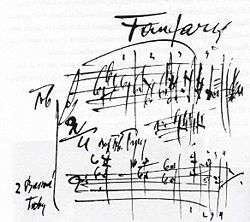Sinfonietta (Janáček)

The Sinfonietta (subtitled “Military Sinfonietta” or “Sokol Festival”) is a very expressive and festive, late work for large orchestra (of which 25 are brass players) by the Czech composer Leoš Janáček. It is dedicated “To the Czechoslovak Army” and Janáček said it was intended to express “contemporary free man, his spiritual beauty and joy, his strength, courage and determination to fight for victory.” It started by Janáček listening to a brass band, becoming inspired to write some fanfares of his own. When the organisers of the Sokol Gymnastic Festival approached him for a commission, he developed the material into the Sinfonietta. He later dropped the word military. The first performance was in Prague on 26 June 1926 under Václav Talich. Typical performance duration is 20–25 minutes.
Orchestration
The score calls for the following orchestra with expanded brass section:
|
|
*) The nine C trumpets, the bass trumpets, and tenor tubas are heard only in the first and last movements.
Structure
The piece is in five movements, all of which have descriptive subtitles:
- I. Allegretto — Allegro maestoso (Fanfare)
- II. Andante — Allegretto (The Castle, Brno)
- III. Moderato (The Queen's Monastery, Brno)
- IV. Allegretto (The Street Leading to the Castle)
- V. Andante con moto (The Town Hall, Brno)
The work is typical of Janáček's tight construction, the material of each movement deriving from the opening motif. It features several variants based on Janáček's original fanfare. The first movement is scored only for brass and percussion. The second movement begins with a rapid ostinato from the wind, but later has a more lyrical episode. The third begins quietly in the strings, but is interrupted by a stern figure in the trombones, leading to another fast dance-like passage. In the fourth movement, Janáček celebrates the newly liberated Czechoslovakia with a joyous trumpet fanfare. The finale begins in the key of E-flat minor with a calm retrograde version of the opening melody. However, this quickly moves into a triumphant finale, the return of the opening fanfare decorated with swirling figures in the strings and wind.
Arrangements
The work was transcribed for symphonic wind ensemble by Don Patterson in 1994. This work was also used by the progressive rock band "Emerson, Lake and Palmer" for their piece entitled "Knife-Edge"
- Arrangement suitable for: orchestra
- arrangement for: brass ensemble
- arrangement by: Rolf Smedwig
- performed by: Empire Brass
- Arrangement suitable for: orchestra
- arrangement for: brass band
- arrangement by: Steven Hamstra
- performed by: Brass Band De Wâldsang, co Rieks van der Velde
- Arrangement suitable for: orchestra
- arrangement for: brass sextet
- arrangement by: František Jílek
- performed by: Brno Czech Brass Sextet
- Arrangement suitable for: orchestra
- arrangement for: wind orchestra
- arrangement by: Karel Bělohoubek
- performed by: Czech Army Central Band, co Vladimír Válek
- Arrangement suitable for: orchestra
- arrangement for: wind orchestra
- arrangement by: Hynek Sluka
- performed by: Prague Castle Guard and Police Wind Orchestra, co Miroslav Hanzal
- Arrangement suitable for: orchestra
- arrangement for: wind ensemble
- arrangement by: Merlin Patterson
- performed by: University of Houston Wind Ensemble, co Eddie Green
- Arrangement suitable for: orchestra
- arrangement for: organ
- arrangement by: Josh Perschbacher
- performed by: org Josh Perschbacher
Selected recordings
- Břetislav Bakala/Czech Philharmonic: Supraphon 1203-V (1950)
- George Szell/Cleveland Orchestra: Sony 88697 58952 2
- Karel Ančerl/Czech Philharmonic: Supraphon 3684
- Simon Rattle/Philharmonia Orchestra: EMI 5-66980-2
- Sir Charles Mackerras/Vienna Philharmonic: London 410138-2
- André Previn/Los Angeles Philharmonic: Telarc CD-80174
- František Jílek/Brno Philharmonic Orchestra: Supraphon 110282-2
- Libor Pešek/Philharmonia Orchestra: Virgin VC791506-2
- Jose Serebrier/Brno Philharmonic Orchestra: Reference Recordings HCDC
Media
 |
|
| Problems playing this file? See media help. | |
Appearances and references in other work
A rearrangement of the opening of the Sinfonietta was used by the progressive rock band Emerson, Lake & Palmer for its song “Knife-Edge” on their debut album.
The opening of the fourth movement (usually no more than about 40 seconds of it) was used as the theme tune for the UK Granada Television series Crown Court during the 1970s and 1980s, although it was never heard in full in any episode. It would be during this opening that the court reporter, Peter Wheeler, would, as a voice-over, either set the scene for a new fictional, yet legally accurate case (in terms of the laws of England and Wales) or else describe the proceedings that had occurred in previous episodes.
The third movement, Moderato (The Queen's Monastery), was the inspiration and soundtrack for the animated film The Queen's Monastery by Emma Calder.[1][2]
Haruki Murakami's novel 1Q84 begins with the Sinfonietta playing on a taxi's radio. The work then appears several times later in the novel as a recurring theme connecting the two main characters. The popularity of the novel has led to an increase in sales of recordings of the Sinfonietta in Japan.[3]
References
- ↑ http://www.imdb.com/title/tt0219989/?ref_=fn_al_nm_1a=undefined
- ↑ Elsey, Eileen. In Short: A Guide to Short Film-Making in the Digital Age. (BFI Modern Classics). ISBN 978-0851708935.
- ↑ Morales, Daniel. "The knock-on effect of Murakami's "1Q84" series". The Japan Times presents Japan Pulse. The Japan Times. Retrieved 18 April 2013.